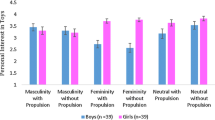Abstract
Hormone transfer theory predicts thatopposite-sex twins will be affected in utero by thehormones their twins produce. This study examines theprediction that opposite-sex dizygotic twins should showless stereotyped toy play than same-sex dizygotictwins should show less stereotyped toy play thansame-sex dizygotic twins as a result of exposure toopposite-sex hormones in utero. Participants in thisstudy included 32 male-female dizygotic twin pairs,27 female-female pairs, and 24 male-male pairs. Allranged in age from 7 to 12 years and were primarilyCaucasian and middle class. Differences in the amount of time children played with feminine,masculine, and neutral stereotyped toys during free playwere examined. Results did not support hormone transfertheory. Girls played with feminine toys more than boys and boys played with masculine toys morethan girls, but there were no significant differencesbetween children with opposite- vs. same-sextwins.
Similar content being viewed by others
REFERENCES
Bem, S. L. (1983). Genital knowledge and gender constancy in preschool children. Child Development, 60, 649–662.
Berenbaum, S. A., & Hines, M. (1992). Early androgens are related to childhood sex-typed toy preferences. Psychological Science, 3, 203–206.
Berenbaum, S. A., & Snyder, E. (1995, January). Early hormonal influences on childhood sex-typed activity and playmate preferences: Implications for the development of sexual orientation. Special Issue: Sexual orientation and human development. Developmental Psychology, 31, 31–42.
Block, J. H. (1983). Differential premises arising from differential socialization of the sexes: Some conjectures. Child Development, 54, 1335–1354.
Caldera, Y. M., Huston, A. C., & O'Brien, M. (1989). Social interactions and play patterns of parents and toddlers with feminine, masculine, and neutral toys. Child Development, 60, 70–76.
Ehrhardt, A. A., & Backer, S. W. (1974). Fetal androgens, human central nervous system differentiation, and behavioral sex differences. In R. C. Friedman, R. M. Richart, & R. L. Vande Wiele (Eds.), Sex differences in behavior. New York: Wiley.
Eisenberg, N., Wolchik, S. A., Hernandez, R., & Pasternack, J. F. (1985). Parental socialization of younger children's play: A short-term longitudinal study. Child Development, 56, 1506–1513.
Elizabeth, P. H., & Green, R. (1984). Childhood sex-role behaviors: Similarities and differences in twins. Acta Genetical Medicae et Gemellologiae: Twin Research, 33, 173–179.
Fagot, B. I. (1974). Sex differences in toddlers' behavior and parental reaction. Developmental Psychology, 10, 554–558.
Fagot, B. I. (1978). The influence of sex of child on parental reactions to toddler children. Child Development, 49, 459–465.
Fagot, B. I., & Hagan, R. (1991). Observations of parent reactions to sex-stereotyped behaviors: Age and sex effects. Child Development, 62, 617–628.
Goldsmith, H. H. (1991). A zygosity questionnaire for young twins: A research note. Behavior Genetics, 21, 257–269.
Grotevant, H. D. (1978). Sibling constellations and sex-typing of interests in adolescence. Child Development, 49, 540–542.
Hines, M., & Collaer, M. L. (1993). Gonadal hormones and sexual differentiation of human behavior: Developments from research on endocrine systems and studies of brain structure. Annual Review of Sex Research, 4, 1–48.
Leventhal, G. S. (1970). Influence of brothers and sisters on sex role behavior. Journal of Personality and Social Psychology, 16, 452–465.
Lloyd, B., & Smith, C. (1985). The social representation of gender and young children's play. British Journal of Developmental Psychology, 3, 65–73.
Lytton, H., & Romney, D. M. (1991). Parents' sex-related differential socialization of boys and girls: A meta-analysis. Psychological Bulletin, 109, 267–296.
Lytton, H., Singh, J. K., & Gallagher, L. (1995). Parenting twins. In M. H. Bornstein (Ed.), Handbook of parenting: Vol. 1, Children and parenting. Hillsdale: Lawrence Erlbaum Associates.
Maccoby, E. E., & Jacklin, C. N. (1974). The psychology of sex differences. Stanford, CA: Stanford University Press.
Meyer-Bahlburg, H. F. L., Sandberg, D. E., Dolezal, C. L., & Yager, T. J. (1994). Gender-related assessment of childhood play. Journal of Abnormal Child Psychology, 22, 643–660.
Miller, E. M. (1994). Prenatal sex hormone transfer: A reason to study opposite-sex twins. Personality and Individual Differences, 4, 511–529.
O'Brien, M., & Huston, A. C. (1985). Development of sex-typed play behavior in toddlers. Developmental Psychology, 21, 866–871.
Resnick, S. M., Gottesman, I. I., & McGue, M. (1993). Sensations seeking in opposite-sex twins: An effect of prenatal hormones? Behavior Genetics, 23, 323–329.
Schachter, F. F. (1982). Sibling deidentification and split-parent identification. In M. E. Lamb & B. Sutton-Smith (Eds.), Sibling relationships: Their nature and significance across the lifespan. Hillsdale, NJ: Lawrence Erlbaum Associates.
Schachter, F. F., Gilutz, G., Shore, E., & Adler, M. (1978). Sibling deidentification judged by mothers: Cross-validation and developmental studies. Child Development, 49, 543–546.
Stoneman, Z., Brody, G. H., & MacKinnon, C. E. (1986). Same-sex and cross-sex siblings: Activity choices, roles, behavior, and gender stereotypes. Sex Roles, 15, 495–511.
Sutton-Smith, B., & Rosenberg, B. G. (1970). The sibling. New York: Holt, Reinhart, and Winston.
Rights and permissions
About this article
Cite this article
Rodgers, C.S., Fagot, B.I. & Winebarger, A. Gender-Typed Toy Play in Dizygotic Twin Pairs: A Test of Hormone Transfer Theory. Sex Roles 39, 173–184 (1998). https://doi.org/10.1023/A:1018894219859
Issue Date:
DOI: https://doi.org/10.1023/A:1018894219859




